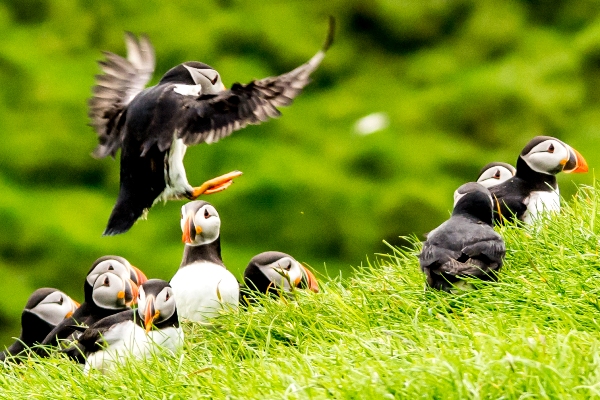The moment 8 of us stepped out of the helicopter, we pretty much doubled the population of the island. Only 9 permanent residents remain on Mykines, the westernmost of the Faroe Islands and yet as I walked between the 40 or so houses in the island’s only settlement it was hard not to believe that I’d just arrived before everyone had woken. The houses were generally well maintained, with curtains hanging and ornaments scattered on the window sills. Peering through the windows of the school it would not have been a surprise to see a dozen or so children piling into the class; and yet there’s only one child left on the island, with a teacher flown in specially to deliver some highly-personalised lessons. Mykines is a community that has slowly dwindled, and while the houses are now mostly empty, they are certainly not being left to ruin.
But the main stars of Mykines are the puffins and I was soon leaving the village with local guide Michael Davidsen, who was taking me up to the lighthouse at the western tip of the island. In true Faroese style, the walk starts with a steep climb (there are no flat walks in the Faroe Islands – it’s a miracle that a large enough flat spot was found to build the islands’ only single airstrip). Michael is a retired fisherman and tells me about his life at sea and the gradual demise of Mykines as a viable community as its residents continue their exodus; there were over 150 people living in the village only 70 years ago.
Soon enough we spy the first puffins, flapping their wings furiously as they make low passes over the ocean. As we descend to the suspended bridge which links the two fragments of Mykines, we’re confronted by hundreds of puffins, perching on the cliff edges and disappearing into their nesting holes. One sits impassively as we walk by, no more than 3 metres away. They’re a magical sight, with their comical faces and awkward attempts at flying (yet they fly thousands of miles every year). Michael points down to the ocean where we see thousands of black dots bobbing in the calm water. “There they are,” he says. “The other day I was here and there were thousands of puffins flying around. Today they are in the water.”
On the bridge itself we stop to take in the view and see the kittiwakes, nesting in the most precarious ledges within the cliff face. Some have newborn chicks and we see the occasional tiny head pop out from beneath its mother’s body.
The rain arrives and as we get nearer to the lighthouse it disappears suddenly from our view. Undeterred we take shelter by the old lighthouse keeper’s cottage and wait for the weather to change before our return trip. Fortunately we were warned about the fickle nature of the Faroese weather and arrived well prepared with decent waterproofs. As the sun reappears we pass the puffins again and are delighted to see that many of the black dots we’d previously seen in the water and now flying frantically overhead, landing nearby and resting for a while before taking off into the wind for another circuit.
Mykines may well be in the final years of human habitation. Most of the few remaining residents are elderly and when they are no longer here it’s likely the island’s houses will serve as holiday homes. But while the puffins remain Mykines will remain a highlight for any visitor who comes to this North Atlantic outpost.
by Andy Jarosz





